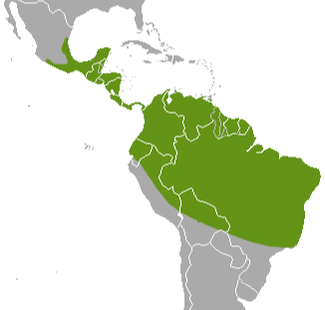|
Kinkajou (pronounced KINK a joo) lives in the tropical rainforest of Belize, also knows as the "Night Walker" by locals. Their habitat ranges from southern Mexico down to Brazil. The Kinkajou are varnivores mammals from the family Procyonidae (related to olingos, coatis, raccoons, ringtail and cocmistle. The scientific name for the kinkajou is Potos flavus. This roughly translates to golden drinker, as the kinkajou has a golden-brown coat and is fond of nectar. The common name kinkajou comes from a word that means honey bear, as this slender animal raids beehives for the golden liquid. As you might have guessed, the kinkajou has quite a sweet tooth! Looking a bit like a monkey, kinkajous are often mistakenly called primates. They do have many traits and features like those of primates. Native to Central America and South America, this mostly frugivorous mammal is not an endangered species, though it is seldom seen by people because of its strict nocturnal habits. However, they are hunted for the pet trade, for their skins (to make wallets and horse saddles) and for their meat. They may live up to 40 years in captivity. Its small, hand-like feet have fingers that are a bit webbed and end with a sharp claw. Their dense, woolly fur acts as a raincoat to help keep them dry. The kinkajou's tail is longer than its head and body and is thickly furred and slightly prehensile. Kinkajous and binturongs are the only two carnivores that have a prehensile tail. The tail is for balance, to hold onto branches while reaching for food, and even to snuggle with while sleeping. Kingajous can hang by the tip of their strong tail, then turn their body in such a way that they can climb back up their own tail. Physical characteristics The kinkajou belongs to the raccoon family and is directly related to the red panda that lives in China, the olingo, the civet and cacomistle, which are considered New World residents. The kinkajou has a round head, small ears, large eyes, sharp teeth, a short pointed snout, short limbs, long body, thick brown fur and a long prehensile tail. The total head-and-body length (including the tail) is between 32 to 52 inches, and the tail measures 15 to 22 inches. The weight ranges from 3.1 to 10.1 pounds. Females are generally smaller than males. Their ears are short & rounded (measuring 1.4 to 2.1 inches). Kinkajous have an excellent sense of touch and smell, but very poor vision. They cannot see color; they also cannot sense differences in colors. With this poor vision the kingkjous rely heavily on their keen sense of touch and smell to avoid predation. The eyes reflect green or bright yellow against light. They cannot see color; and they cannot sense differences in colors. Their snout is dark brown to black. Their long (5-inch) tongue is long, thick and highly extrudable, this allows them to reach nectar and honey that otherwise may be out of reach for other animals. For this reason, they are often referred to as a "Honey Bear", or the “ Night Walker.” The coat color varies throughout the range and at different times of the year. The fur is short, woolly and dense. Hairs are of two types: ligh yellowish and darker with brown tips. The darker hairs reflect light poorly relative to the lighter ones, often creating an illusion of spots and dark lines on their coats. Several shades such as tawny olive, wood brown and yellowish tawny have been reported for the upper part of the coat and the upper side of the tail, while the underparts and the lower side of the tail have been observed to be buff, tawny or brownish yellow. The kinkajou has a long tail that helps to balance the animal and it is also used as a fifth hand so to speak to help in climbing. The tail is covered with thick fur up to the end. Behavior Kinkajous are nocturnal animals meaning that they are primarily active at night and they are arboreal (tree dwelling). There peak activity is between 7:00 P.M. until midnight and then again about an hour before dawn. During the day they sleep in the tree hollows or somewhere in the shade to avoid the sunlight. Kinkajous live in the warm humid lowland rainforests of Central and South America, where the temperatures range from the upper 70’s to 100 degrees. They usually live at high elevations not exceeding 2,200 meters. They spend most of their life in trees (which they are well adapted), living in the forest canopy and seldom descend to the forest floor. Kinkajous are extremely agile and fast, traveling quickly along the tree tops, jumping noisily from tree to tree. Kinkajous are deliberate in their every movement, carefully placing all legs and the tail for the best balance. By rotating their hind ankles, kinkajous can climb down a tree’s trunk headfirst. This helps them make a quick escape from larger, tree-climbing predators such as jaguars, ocelots, and margays. There is danger from above as well, in the form of harpy eagles. Kinkajous look for dark hideaways just before dawn, the magical hour for predation. If they are not well concealed by this time, a predator might surprise them during sleep. They are in the same family as raccoons, and have a similar role in rainforest ecosystems that raccoons do in temperate forest ecosystems. The kinkajou has a short-haired, fully prehensile tail (like some New World monkeys), which it uses as a "fifth hand" in climbing. It does not use its tail for grasping food. Kinkajous sleep in family units and groom one another, while they generally are solitary when it comes to foraging. As for communicating with each other, they do so by scent glands located near their mouth, throat, and belly. They will mark their territory and their travel routes by using these scent glands. They also communicate by vocal calling ranging from soft chirps to shrill screams. Fun Facts About Kinkajous Known In Belize As: Honey Bear or Night Walker Animal Type: Mammal Diet: Omnivore Life span: 20 to 25 years, although one at the Belize Zoo lived 39 years Gestation: 112 to 118 days Number of young at birth: 1 to 2 Weight at birth: 2 ounces (55 grams) Age of maturity: 18 to 20 months Young Gestation: 100 to 120 days Size/Length: 16 to 30 inches (42 to 76 centimeters) Weight: 3 to 10 pounds Tail length: 15 to 22 inches (40 to 57 centimeters) Hearing: A kinkajou's hearing is sharp enough to detect the movement of a snake. Feet: A kinkajous is able to turn their feet in the opposite direction to run backwards. This makes it easy for them to climb up and down trees headfirst. KINKAJOU HABITAT RANGE Range & Habitat Kinkajous are nocturnal mammals native to the lowland rainforests of Central and South America. Their habitats range from eastern and southern Mexico through Belize and Costa Rica in Central America and down as far south as Ecuador and southern Brazil in South America. Their altitudinal range is from sea level to 2500 m. They are found in closed-canopy tropical forests, including lowland rainforest, montane forest, dry forest, gallery forest and secondary forest. Deforestation is thus a potential threat to the species. At home in rain forests, tropical evergreen forests, some dry forests and even forests that grow in savanna regions, such as those found in Belize, Kinkajous are arboreal and nocturnal, making them difficult to watch and study. Rather than come down from the branches high in the rain forest canopy, they travel from tree to tree via overlapping branches. During the day, kinkajous find a hollow or crook in a tree to sleep or hide in; they may use the same spot or a new one each day. Their spine is quite flexible, allowing them to curl into tight spots. They sleep alone or with another individual within their social group.  DIET Although kinkajous are classified as carnivores (they have canine teeth), 90% of their diet is (primarily ripe) fruit and nectar. They sometimes each insects, particulary ants. On rare occasions they eat eggs, hatchlings, insects, and small vertebrates. To eat softer fruits, they hold it with their forepaws, then scoop out the scuuclent pulp with their tonuge. This (5-inch-long) tongue can reach inside flowers or beehives for tasty honey or nectar. Their short, dense fur provides a natural protection from bee stings. Their dexterous paws help them manipulate food. Kinkajous often hang by their tail while reaching for their next piece of fruit!Kinkajous play an important role in seed dispersal and are important pollinators. Leaves, flowers and various herbs make up about 10% of their diet. As they travel from flower to flower to drink nectar, the flower’s pollen sticks to their face and then smears off onto the next flower. Their foraging habits drive them to travel between a variety of trees each night. Several kinkajous may meet and forage together at the same site, if there is enough fruit to share. It is noted, that captive Kinkajous will avidly eat honey (hence the name "honey bear"), yet honey has not been observed in the diet of wild kinkajous. FAMILY LIFE Scientists consider kinkajous to have a “solitary group-life.” This means an individual spends most of its time alone but may join others when feeding on fruiting trees. Individuals may also gather to socialize. They play, groom, and sometimes even sleep together. A typical kinkajou social group includes two males, a female, and offspring. Whether alone or in a small group, kinkajous usually travel the same route each night and tend to stick to their own territory. Scent glands at the corner of the mouth, the throat, and the abdomen help kinkajous mark their territory. Kinkajous can be quite noisy with their high-pitched squeaks, hisses, and barks. Reproduction & Babies The kinkajou becomes sexually mature between 18 and 20 months. Males reach maturity at about 1.5 years and females 2.5 years. They breed all year long, with the female being in heat about every three months. Out in their natural habitat the kinkajous usually avoid each other except when mating. After a gestation period ranges from 3 to 4 months and they usually have 1 to 2 cubs born each time. Births in the wild usually occur between April and December. The cub is born in a dark den with their eyes and ears closed. Their eyes open within two to six weeks, and in another three to six weeks their tails become prehensile. A mother kinkajou takes full responsibility for caring for her young. She gives birth in the hollow of a tree. This is where she leaves her baby while she looks for food. After one or two weeks, the baby's eyes open. It begins to eat solid food at eight weeks. By this time, the youngster can hang by its tail. It is able to climb with confidence when about three months old. Young males stay with their mother until they are about 18 months old; females stay until they are about two years old. The kinkajou mother is very protective of her cub. During times of danger she will carry the infant upside down just below her chest. The mother carries the young for almost four months, at which time the young are almost independent. Lifespan and Current Status Kinkajous live approximately 20 to 25 years. Their main predators in the wild include the tayra, fox, jaguarundi, jaguar, ocelot, and humans. They are often hunted for their meat and fur. The kinkajou is not currently on the endangered species list, however their status in the wild is threatened. Deforestation and fur hunting have taken a significant toll on the current population of kinkajous. Personal Interest - as Pets Kinkajous are sometimes kept as exotic pets, although it is not recommended to do so. Many wildlife lovers find them playful, quiet and docile by nature, with very little odor. Keep in mind, these are wild animals, no matter how cute you might think they are. Kinkajous can deliver a painful bite and can be destructive to a home in the middle of the night, when they are most active. They do not like sudden movements, noise, and being awake during the day. An agitated kinkajou may emit a scream and attack, usually clawing its victim and sometimes biting deeply. In 2011, the Centers for Disease Control and Prevention reported that pet kinkajous in the United States can be carriers (fecal–oral route) of the raccoon roundworm Baylisascaris procyonis, which is capable of causing severe morbidity and even death in humans, if the brain is infected. They live an average of about 23 years in captivity, with a maximum recorded life span of 41 years. BELIZE ZOO Fuzzy the kinkajou, is a new arrival to the zoo. Fuzzy was a pet for two years and to the surprise of our staff, his owner brought him to the zoo minus any cage. They rode the bus together, he stayed snuggled around her neck, and we wondered if Fuzzy had to pay busfare! They both arrived safely to the zoo, and we accepted Fuzzy into the zoo clan. He stayed off-site so he could become used to zoo staff and the standard tender loving care given to the animals here. His diet was vastly improved. Many times, when people keep wildlife as pets, they do not provide a balanced diet for them, and this can result in various deficiencies, sickness and an overall weak condition. Fuzzy needed a bit of upgrading in his daily meals, and in a short time, his golden coat was glowing and his behavior reflected that of a healthy and very happy kinkajou. The kinkajou, or “nightwalker” as we also know them in Belize, is closely related to raccoons and coatimundis. Even though they are classified as carnivores, they prefer to dine on sweet fruits, flower nectar, and sometimes insects. They preference for sweets earned them the nickname “honey bears.” In order to fulfill the “carnivore” part of his identity, we provide Fuzzy with a bit of chicken. Turning upside down, Fuzzy will eat the chicken as if it were the treat of a lifetime! What else is on the menu? Papaya, watermelon and of course, bananas, satisfy the boy’s appetite here at the Zoo. Fuzzy will become one of the highlights of the Zoo’s night tour, along with other nocturnal critters like the owls, tapirs, and jaguars!
0 Comments
Your comment will be posted after it is approved.
Leave a Reply. |
Is located on the island of Ambergris Caye, directly across from the Belize Barrier Reef, off the mainland coast of Belize. The property is nestled in a cluster of Australian Pine trees, backed to a littoral jungle, and surrounded by tropical gardens. It's about a one minute walk from the property to the beach, and a 10-15 minute drive from the island airstrip to the property.
We offer one bedroom suites (455 s.f.) of living area to include: livingroom, kitchenette, private bathroom and bedroom. We are also about a one minute walk from one of the best restaurants on the island serving (breakfast, lunch & dinner). Within walking distance you can find: (3) blocks is Robyn's BBQ (4) blocks is 2 fruit stands (5) blocks local grocery store IF YOU'RE COMING TO BELIZE TO............... If you're coming to Belize to dive the Blue Hole, descend the shelf walls at Turneffe, snorkel the Barrier Reef, explore Mayan ruins, rappel into a cave, kayak along the river through caves, zip line through jungle tree tops, hike through a cave to see an ancient human skeleton, swim with sharks, listen to Howler Monkey's, hold a boa constrictor, feed a jaguar, horseback ride through the jungle, canoe through a cave, rappel down a waterfall, sail around an island, enjoy cocktails & dinner to a sunset, climb 130' feet to the top of a Mayan ruin, rip up the jungle trails on an ATV, float through a series of caves on a tube, and sip on a rum punch..... then this is the place for you. Belize Budget Suites, offers you clean, affordable, attractive, accommodations, at prices that allow you to do all the things just mentioned. Archives
February 2021
Categories
All

For All Your Home Improvement Needs

For all Your Real Estate Needs
501-226-4400 10 Coconut Dr. San Pedro, Belize Your Ad Could Go Here
|














 RSS Feed
RSS Feed























